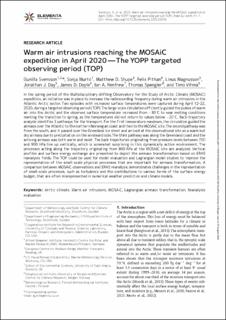| dc.contributor.author | Svensson, Gunilla | |
| dc.contributor.author | Murto, Sonja | |
| dc.contributor.author | Shupe, Matthew D. | |
| dc.contributor.author | Pithan, Felix | |
| dc.contributor.author | Magnusson, Linus | |
| dc.contributor.author | Day, Jonathan J. | |
| dc.contributor.author | Doyle, James D. | |
| dc.contributor.author | Renfrew, Ian A. | |
| dc.contributor.author | Spengler, Thomas | |
| dc.contributor.author | Vihma, Timo | |
| dc.date.accessioned | 2023-08-15T08:39:42Z | |
| dc.date.available | 2023-08-15T08:39:42Z | |
| dc.date.created | 2023-07-27T12:23:12Z | |
| dc.date.issued | 2023 | |
| dc.identifier.issn | 2325-1026 | |
| dc.identifier.uri | https://hdl.handle.net/11250/3084033 | |
| dc.description.abstract | In the spring period of the Multidisciplinary drifting Observatory for the Study of Arctic Climate (MOSAiC) expedition, an initiative was in place to increase the radiosounding frequency during warm air intrusions in the Atlantic Arctic sector. Two episodes with increased surface temperatures were captured during April 12–22, 2020, during a targeted observing period (TOP). The large-scale circulation efficiently guided the pulses of warm air into the Arctic and the observed surface temperature increased from −30°C to near melting conditions marking the transition to spring, as the temperatures did not return to values below −20°C. Back-trajectory analysis identifies 3 pathways for the transport. For the first temperature maximum, the circulation guided the airmass over the Atlantic to the northern Norwegian coast and then to the MOSAiC site. The second pathway was from the south, and it passed over the Greenland ice sheet and arrived at the observational site as a warm but dry airmass due to precipitation on the windward side. The third pathway was along the Greenland coast and the arriving airmass was both warm and moist. The back trajectories originating from pressure levels between 700 and 900 hPa line up vertically, which is somewhat surprising in this dynamically active environment. The processes acting along the trajectory originating from 800 hPa at the MOSAIC site are analyzed. Vertical profiles and surface energy exchange are presented to depict the airmass transformation based on ERA5 reanalysis fields. The TOP could be used for model evaluation and Lagrangian model studies to improve the representation of the small-scale physical processes that are important for airmass transformation. A comparison between MOSAiC observations and ERA5 reanalysis demonstrates challenges in the representation of small-scale processes, such as turbulence and the contributions to various terms of the surface energy budget, that are often misrepresented in numerical weather prediction and climate models. | en_US |
| dc.language.iso | eng | en_US |
| dc.publisher | University of California Press | en_US |
| dc.rights | Navngivelse 4.0 Internasjonal | * |
| dc.rights.uri | http://creativecommons.org/licenses/by/4.0/deed.no | * |
| dc.title | Warm air intrusions reaching the MOSAiC expedition in April 2020- The YOPP targeted observing period (TOP) | en_US |
| dc.type | Journal article | en_US |
| dc.type | Peer reviewed | en_US |
| dc.description.version | publishedVersion | en_US |
| dc.rights.holder | Copyright 2023 The Author(s) | en_US |
| dc.source.articlenumber | 00016 | en_US |
| cristin.ispublished | true | |
| cristin.fulltext | original | |
| cristin.qualitycode | 1 | |
| dc.identifier.doi | 10.1525/elementa.2023.00016 | |
| dc.identifier.cristin | 2163772 | |
| dc.source.journal | Elementa: Science of the Anthropocene | en_US |
| dc.identifier.citation | Elementa: Science of the Anthropocene. 2023, 11 (1), 00016. | en_US |
| dc.source.volume | 11 | en_US |
| dc.source.issue | 1 | en_US |

